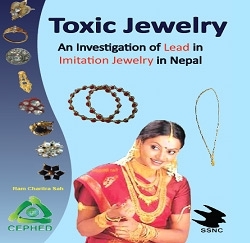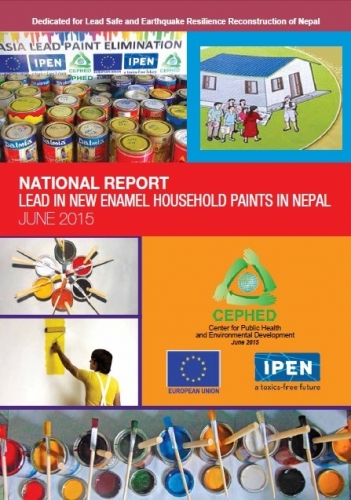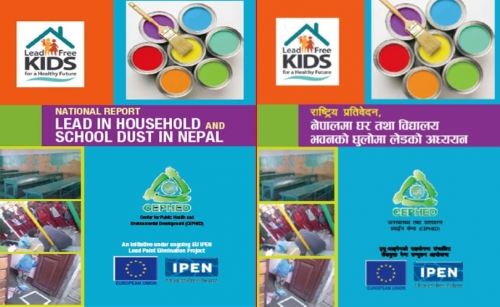Lead (R)

Lead (R)Lead as one of ten chemicals of major public health concern requires action to protect the health of workers, children and women of reproductive age. According to World Health Organization (WHO), 143000 annual deaths or 0.6% of global burden of disease causes by lead exposure.
Every year, nearly 600000 new cases of children suffering from intellectual disabilities due to lead exposure have been found. And about 99% of children affected by high exposure to lead belongs to low and middle income countries.
Lead enters human bodies largely through inhalation, ingestion and absorption. Of total lead enters our bodies, 95% accumulated into the long bones, 4% in soft tissues such as brain, liver and kidney and 1 % blood. Recent World Health Organization (WHO) guidelines indicate that there is no known safe level of lead in blood.
Lead is a naturally occurring element that can be found in all parts of our environment, the air, the soil, the water, and even inside our homes. Lead is toxic to humans and animals causing of several irreversible health problems when ingested or inhaled, particularly to children under the age of six.
These days lead and lead compounds have been used in a wide variety of products found in and around our homes, including paint, ceramics, pipes and plumbing materials, solders, batteries, solar panels and cosmetics etc.
Lead in Nepal's New Enamel Household Paints 2013
 |
From October 2012 to March 2013, Center for Public Health and Environmental Development (CEPHED) conducted a research on decorative paints in order to analyze the lead contamination.
|
Double Standard: Investigating Lead Content in leading Enamel Paint Brand in South Asia, 2011
 |
In late 2010 and early 2011, a second phase study entitled "Double Standard" was conducted on 27 common brand of enamel samples (12 from Nepal, 9 from India and 6 from Bangladesh).
|
Study of Lead in Paint in Nepal, 2010
 |
Almost all and especially enamel samples were found to have heavily leaded ranges from a minimum of 3.98 ppm to a maximum of 73966.44 ppm.
|
Lead in Household and School Dust in Nepal
The report analyzed the following findings:
Schools: One or more samples from 5 out of 5 (100%) schools contained high level of lead with about 77 % (17 out of 22 schools samples) from class rooms floor dust samples contained hazardous levels lead more than 10 �g/ft2 and even 23% (5 out of 22 school samples) contained danger level of lead more than 40 �g/ft2 . The maximum lead level in school were found 108 �g/ft2 is the single source in class room for high level of lead exposure that comes from leaded pints on the wall, desk, bench, window and door.
Hospitals: All samples taken at two hospital buildings were found to have low levels of lead contamination.
Residential Homes: One or more samples from 6 out of 16 (38%) residential homes contained high level of lead with about 13 % (6 out of 47 residential house samples) of the floor dust samples contained hazardous levels lead more than 10 �g/ft2 .
In order to protect the children�s health from lead exposure contained in paints and thus in dust, the report made following recommendations to be adopted and effectively implemented towards protection of children, the future of Nepal.
- The Government and government agencies should immediately take measures banning the manufacture, importation, distribution, sale and use of household paint products with lead levels that constitute a health hazard, and take the decisions of Green Public Procurement Policy (GPPP).
- Paint Industry, Nepal Paint Manufacturers Associations and Chamber of Commerce Organizations should discontinue the use of lead as driers or pigments and other purposes in paint formulations and shift to non-lead substitutes.
- The Department of Education, Ministry of Education and School Organizations (PABSON, N PABSON) should require Material Safety Data Sheets and labels indicating lead content when purchasing paints and toys and make a mandatory circular or notification to all schools, colleges in both public and private sectors to only use non-leaded paints.
- Consumers should ask for unleaded paints for safer homes and patronize businesses that sell unleaded paints; give children regular blood level check-ups.
- The advertising agencies, Media houses and celebrities should understand the dangers of lead in paint for children, ask paint clients about the ingredients they use before advertising and avoid supporting paints containing lead at levels dangerous to children.
Study of Lead in Trinkets /Artificial Jewelry
 |
As there is low level of awareness and completely absence of any regulatory authority as well as any regulatory framework, an indicative study Lead in Artificial Jewelry has been conducted by conducting laboratory testing of several 17 types of Jewelry ranges from ear rings, finger rings, chains, tops, bangles with plastic, silver and gold coated were included into the study.
Certain types of Jewelry found in Nepalese market and mostly used by the general public have been found to be contained very high amount of lead ranges from 28 to 775500 ppm hazardous for health of people especially child bearing age and lactating female. |
Study of Lead in Cosmetics (Lead in Lipsticks)
 |
The branded included into the study were Revlon, Loreal Paris, Lakme, MAC, Schisciedo, Dily, Channel and Midie. Certain brands of Lipstick found in Nepalese market and mostly used by the general public have been found to be contained very high amount of lead ranges from 30 to 145 ppm hazardous for health of people especially child bearing age and lactating female. |
National Report: Lead in New Enamel Households in Nepal, 2015
 |
This is the fourth study CEPHED has released about the lead content of new decorative enamel paints in Nepal. The paint study was undertaken as part of the Asian Lead Paint Elimination Project. The Asian Lead Paint Elimination Project carries out focused activities to eliminate lead paint from the market in seven project countries Bangladesh, India, Indonesia, Nepal, Philippines, Sri Lanka, and Thailand. Summary of Results of Paint Lead Levels in Nepal:: Nearly 9 out 10 (89 percent) of all paints in the study exceed Nepal's recently gazette standard of 90 ppm and will be illegal after June 20, when the new law takes effect. The highest level detected was 124,000 ppm, 1,378 times greater than 90 ppm standard.:: There has been only a small improvement in lead reduction in paints since CEPHED last tested paints in 2013. Between 2013 and 2015 the percentage of paints with lead concentrations above 90 ppm fell only 4 percentage points, from 95 percent (55 of 58 paints) to 91 percent of the paints (53 of 58 paints). The percentage of paints with lead concentrations greater than 10,000 ppm also dropped only a small amount, from 50 percent (29 of 58 paints) to 45 percent (26 of 58 paints) in 2015.::A substantial number of paint manufacturers will need to need to shift to lead safe paints in order to be compliant with the new law. |
The vast majority (93 percent) of paint companies included in this study produces and sells paint with a lead content above the new Nepalese standard of 90 ppm and nearly three quarters (74 percent) of the paint companies sell paints with dangerously high lead levels above 10,000 ppm.::Green, yellow and red color paints are the most likely to contain dangerously high levels oflead above 10,000 ppm. 100 percent (10 out of 10) of green, Ninety-fi ve percent of yellow (18 out of 19 paints) and 78 percent of red color (14 out of 18 paints contained lead levels higher than 90 ppm.::Paint can labels with Nepal Standard Mark can be Misleading
Celebration of ILPPW 2020 in Nepal
CEPHED successfully celebrated ILPPW 2020 by organizing series of provincial level stakeholder programs on effective implementation of Lead Paint Standard in Nepal and increasing profile of high blood lead level (BLL) among lead Nepalese children. 





